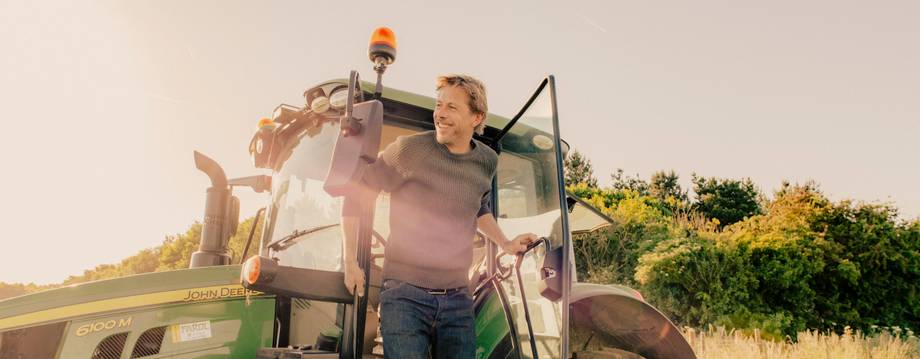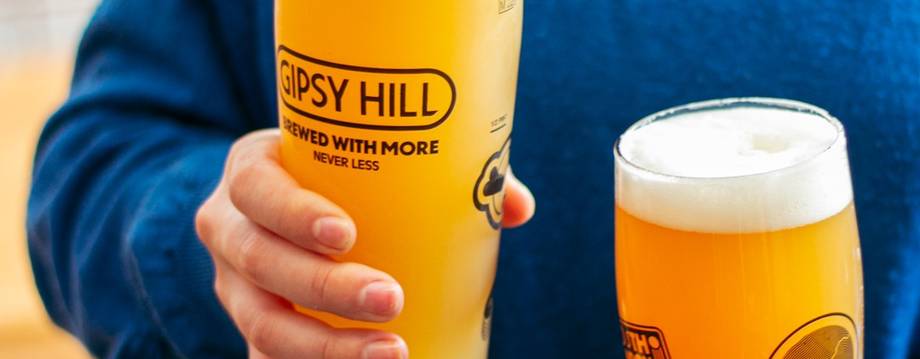Gipsy Hill
Blood, sweat, and the world's lowest carbon beers
Robyn Gilmour
Photos:
Gipsy Hill Brewery
Saturday 06 May 2023

This article is from
Beer On Trend
issue 91
Share this article
“I’ve always had faith that there was a place within sustainability that wasn’t just about ‘tweaking’, and ‘solutions’ that made little difference, but that instead we could really change the game if we focused on our biggest problems” says Sam McMeekin, co-founder and managing director of Gipsy Hill Brewery. “That thought led to ground-breaking innovation in our brewery using all the years of experimenting that we’ve done; it led to the regenerative, organic and bio-diverse farming of our raw materials, our partnership with Wildfarmed, and, ultimately, to Regenerator – one of the lowest carbon beers ever made.”
And that’s no exaggeration. I kick myself for not thinking about sustainability in Regenerator’s terms more instinctively, because as Sam regales the story of Gipsy Hill’s journey to the beer, it becomes increasingly obvious to me that its approach is not only intuitive, but one we, as a society, should have been taking from the outset of our efforts to live in harmony with the planet. Regenerator’s carbon footprint is the result of a multi-pronged approach to sustainability, but the backbone of its efforts lies in Gipsy Hill’s collaboration with Wildfarmed, an organisation that works with farmers embracing a regenerative approach to biodiversity, and offers them a route to market for crops grown in systems that prioritise soil health.
Sam serendipitously stumbled upon Wildfarmed’s bizarre and completely brilliant story in a magazine in 2021. “Andy Cato [Wildfarmed’s co-founder] is one of the two Groove Armada guys” begins Sam, instantly throwing me for a loop. “Basically, in 2007, while Andy was on tour, he read an article about the state of food, and the planet, and basically said sod this, I need to do something about it. He sold the rights to his back catalogue, bought a farm in France and more or less spent the next eight years failing at farming. I think Andy would be fine with me putting it this way”, Sam grins.

“He was trying all sorts of different things to try and figure out a way to farm in an organic and regenerative way that worked, and almost threw in the towel before he read a book from the 1800s about soil health; he began incorporating its suggestions into his method, and things started to work, by which I mean he started producing healthy crops, and reasonable yields. From there, he bought a bakery and used the wheat he grew to make bread that locals were queuing out the door for, saying ‘this bread tastes like it used to taste!’ and all that kind of thing. Anyway, he won an award for his services to agriculture in France, and off the back of that progress, met and teamed up with George Lamb and Edd Lees, who Andy founded Wildfarmed with, and brought the concept of that farming method to the UK.”
After reading Wildfarmed’s story, Sam got in touch. At the time, Wildfarmed mainly worked in wheat – buying crops from its community of regenerative farmers at a fair price, then turning the produce into flour before selling it on – but that didn’t stop Sam asking if their methods could also be used to grow barley. Andy obviously said yes, and the rest, as they say, is history, but being some years out from when that question was first asked, Sam is well positioned to reflect on what connecting with Wildfarmed meant, not only for Gipsy Hill, but for what our industry as a whole could be.
“One of the special things about the way Wildfarmed works, is that they do what's called poly cropping, meaning they plant multi-crop fields. So, for example, in the field where our barley was grown, there was also peas and rapeseed growing. Everything grows alongside each other, so it’s a great big mix in the field, but the result is that there's more carbon sequestration, more nutritionally complex crops produced, and with more biodiversity promoted there's ultimately better soil health and you get a better yield. That’s all because, as it happens, plants like growing together. They like biodiversity. The fact that this is what Regenerator came from is not only amazing because the brewery was able to pick up where regenerative agriculture ends, but because it was a great application of where brewing and farming can integrate”.
Regenerator’s carbon footprint is the result of a multi-pronged approach to sustainability
While there’s no getting away from the fact that barley is the champion of this beer, to work with instead of against the good work done by the grain’s carbon sequestration, Gipsy Hill has had to take an integrated approach of its own, and combine a sustainable method of production with an efficient use of other raw materials in the beer. Alongside taking all the measures you would expect from a brewery concerned with sustainability – using cans instead of bottles, focusing on local business in kegs instead of cans where possible, upgrading to a larger and more efficient brewhouse, and using a centrifuge instead of time separation to get the best yield from each batch of beer it brews – Gipsy Hill has also started using a new piece of kit to an unexpected end.
“We installed a new piece of equipment in the brewery, called a decanter”, begins Sam. “Whereas a normal centrifuge will separate yeast cells and very, very small particles from the beer, hop particles are much larger, so we use the decanter as a sort of primary separation method, to extract those macro particulates from the liquid. When we started doing this we found that the hop matter we separated out of the beer still had a lot of oil intact. From there, we started looking into how we could ultimately reuse these hops, eventually experimenting with what would happen if we reused these on the hot side of the brewing process.”

Andy, Wildfarmed co-founder © Wildfarmed
This was another ah-ha moment during our conversation, when I asked myself why I hadn’t thought of this before, and questioned why I’d never before heard of breweries doing this as standard. I should point out here, as Sam was keen to point out to me, that reusing hops is not like reusing a tea bag, where your second brew is going to be a little more watery, and less flavourful. It’s more like operating a distillation column, similar to that used for processing crude oil. The various polyphenols, alpha acids and other volatile oils that give new world hops their unique flavour and aroma each have a unique flash point. The more volatile the oil, the lower the temperature that the oil will evaporate .Meanwhile, alpha acids, and other less volatile oils, with their higher flash points are essentially unused in the dry hopping process, which occurs on the cold-side of brewing (less than 25°C).
Another way to think of this, is essentially as the inverse of the premise upon which dry hopping was introduced to the brewing process, all those years ago, in California. Anchor Brewing invented dry hopping because adding volatile American hops purely to the boil meant that the most delicate, floral and herbaceous alpha acids in the hops were immediately burned off by the high temperatures; by adding a second addition of hops to the brew at a cooler stage, these flavours and aromas had the time and temperatures they needed to take up residence in the brew, imbuing it with layered and complex flavour and aroma.

What no one seems to have taken stock of until now, is that hops added on the cold side of brewing, don’t lose their ability to flavour and bitter on the hot side also, for all they might never be called on to do so. If we throw hop matter away after dry hopping, we’re essentially pouring hot side hops down the drain. The simplicity of this practice makes me giddy and furious at the same time. I can’t help but think the perspective that makes this practice an obviously practical one, is likely the same mindset that would also think it intuitive to plant multicrop fields. But for all I’m saddened to think of how far we’ve strayed from a sustainable relationship with the planet, for these obvious practices to seem so groundbreaking, I take heart in the very fact of Regenerator’s existence.
Thanks to 100% of the hops used in this beer being reused, and Wildfarmed’s barley actively drawing carbon from the atmosphere back into the earth, Regenerator, in a 330ml can, has a carbon footprint of 130g (vs. 403g for a regular session IPA). I’m interested to discover that a larger 440ml can of the beer would have a footprint of just 80g (vs. 480g for a normal Session IPA) but this time catch myself thinking in patterns that I recognize we need to move beyond in order to engage with Regenerator on its own terms. While a 440ml can contains more aluminium, contributing to the beer’s carbon footprint, a 440ml can also contains more of the beautiful barley that actively eats through that footprint.
So, what if we scaled Regenerator up to a 50L returnable stainless steel keg? Well, as it stands, that would have a carbon footprint of negative 3.5kg, which is probably the world’s first fully carbon negative beer, with no offsets. Now that would change the game.
*all carbon accounting carried out by Zevero.
Header image © Wildfarmed
Share this article

